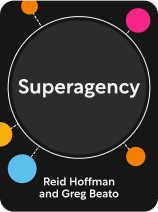Ken Liu’s latest novel ‘All That We See or Seem’ is speculative fiction about AI
In this episode of NPR's Book of the Day, author Ken Liu discusses his new novel about artificial intelligence and shared dreaming. The story follows a hacker investigating an artist collective called Onerofex that uses AI technology to create shared dream experiences. Through this narrative frame, Liu explores how AI systems mirror and amplify human cognitive patterns, drawing parallels between AI and literary figures like Frankenstein's monster.
Drawing from his background as both a programmer and lawyer, Liu approaches storytelling as a form of programming that uses symbols to achieve specific outcomes. Rather than trying to predict the future of AI, he focuses on creating mythology around emerging technology while examining how human thought processes influence the technological world we build.

This is a preview of the Shortform summary of the Oct 20, 2025 episode of the NPR's Book of the Day
Sign up for Shortform to access the whole episode summary along with additional materials like counterarguments and context.
1-Page Summary
Premise and Themes of Ken Liu's "All That We See or Seem"
Ken Liu's latest novel explores the relationship between artificial intelligence and human nature through the story of Julia Z, a hacker investigating the disappearance of an artist from the mysterious "Onerofex" collective. The collective uses AI to create shared dreamscapes, while Julia battles both external challenges and internal demons that Liu hints will play significant roles in future series installments.
Ken Liu's Nuanced Depiction of AI in Fiction
Rather than attempting to predict AI's future, Liu sees his role as creating mythology around emerging AI technology. He draws parallels between AI systems and Frankenstein's monster, suggesting that like the creature learning from human literature, AI reflects and amplifies human cognitive patterns. Through this lens, Liu crafts narratives that encourage readers to think deeply about technology's societal impact.
Onerofex: Using AI to Guide Collective Dreams
The Onerofex artists pioneer a unique form of performance art by using AI to read audience moods and guide them into shared dream states. Liu emphasizes the significance of dreams, arguing that despite society's skepticism, they reveal our core values and deepest aspirations, such as the collective notion of the American dream.
How Ken Liu's Background Influenced His Speculative Fiction Writing
Liu's experience as both a programmer and lawyer shapes his approach to storytelling. He views stories as a form of "original programming," using systems of symbols to produce desired outcomes. In his fiction, Liu explores how human mental patterns manifest as technology, suggesting that our internal thought processes directly influence the technological world we create.
1-Page Summary
Additional Materials
Actionables
- You can explore the intersection of AI and human nature by journaling your interactions with technology. Reflect on how using a smartphone, social media, or even a simple web search affects your mood and thoughts. This personal audit will help you understand the cognitive patterns that AI might be amplifying in your life.
- Start a creative project that mirrors the Onerofex collective's use of AI to reflect societal values. For instance, create a collage or digital artwork that represents your vision of a collective dream, using images and symbols that resonate with your community's aspirations. This doesn't require artistic expertise; it's about expressing your perspective on shared dreams and values.
- Engage in thought experiments to consider the societal impact of technology by imagining a day without any digital devices. Write down how this would change your routine, social interactions, and access to information. This exercise can help you appreciate the depth of technology's integration into society and encourage you to think critically about its role in your life.
Get access to the context and additional materials
Premise and Themes of Ken Liu's "All That We See or Seem"
Ken Liu's "All That We See or Seem" is a novel that delves into the complexities of artificial intelligence and its interplay with human nature.
Ai In Daily Life: Beyond Dystopia or Utopia
Novel Explores Ai's Amplification of Human Tendencies
Ken Liu presents a vision of AI that neither descends into dystopia nor ascends into utopia. Instead, he suggests that AI will amplify our own human tendencies. The narrative explores how artificial intelligence reflects the human condition and potentially magnifies both our virtues and our vices.
Hacker Julia Z Drawn Into Mystery of Missing "Onerofex" Artist
"Onerofex" Artists Use Ai for Collective Dreams
In the story, protagonist Julia Z, a hacker, becomes involved in the mystery surrounding the disappearance of an artist known as "Onerofex." The "Onerofex" artists employ artificial intelligence to create shared dreamscapes, adding layers of complexity to Julia Z's investigatio ...
Here’s what you’ll find in our full summary
Premise and Themes of Ken Liu's "All That We See or Seem"
Additional Materials
Counterarguments
- The suggestion that AI will amplify human tendencies might oversimplify the potential for AI to develop in ways that are independent of direct human traits, leading to unforeseen consequences that are not merely amplifications of human behavior.
- The use of AI in the arts, as depicted with the "Onerofex" artists, could be criticized for potentially devaluing human creativity by implying that AI can replicate or replace the human creative process.
- The focus on a hacker protagonist might perpetuate stereotypes about hackers and overlook the diversity within the hacker community and the variety of motivations that drive individuals in this field.
- The narrative's exploration of Julia Z's internal struggles and past demons could be seen as a common trope in literature, which ...
Actionables
- You can explore the influence of AI on your own behavior by journaling your interactions with technology for a week, noting any changes in your habits or thought patterns. For instance, if you use a fitness app, observe whether it makes you more competitive or cooperative with others, reflecting on how AI might be amplifying these traits.
- Engage with interactive art installations or online platforms that use AI to create experiences, and reflect on your emotional responses. This could be as simple as using an app that generates music based on your mood, allowing you to see firsthand how AI can mirror and potentially intensify human emotions.
- Write a short story or create a visual art ...
Get access to the context and additional materials
Ken Liu's Nuanced Depiction of Ai in Fiction
Liu Sees Sci-fi Writers As Creators of Myth, Not Future Predictors
Ken Liu believes that his role as a sci-fi writer involves shaping mythology around emerging AI technology rather than forecasting its precise future. Through his stories, Liu offers readers conceptual frameworks that provoke thoughtful consideration of AI's potential societal impact.
Narratives Frameworks for Emerging Technologies’ Implications
By crafting a mythology of the future, Liu helps his audience engage thoughtfully with the idea of AI. This myth-making serves as a means to ask provocative questions about technology's role in humanity's path forward, much as "Frankenstein" prompts discussions about the ethics and implications of new technologies.
Liu Compares Ai Systems to Frankenstein's Monster Learning From Human Creativity
Ai Reflects and Amplifies Human Cognitive Patterns
Ken Liu points out that AI can reflect and amplify both the positive and n ...
Here’s what you’ll find in our full summary
Ken Liu's Nuanced Depiction of Ai in Fiction
Additional Materials
Counterarguments
- While Liu emphasizes the role of sci-fi writers in myth-making, one could argue that predicting the future, even if imperfectly, is also an intrinsic part of science fiction's appeal and utility.
- The idea that stories offer frameworks for considering AI's impact might be challenged by suggesting that not all readers interpret stories in the same way, and some may take away different or unintended messages.
- The effectiveness of myth-making in prompting thoughtful engagement can be questioned, as it may also lead to misconceptions or fear-mongering about AI if not grounded in realistic possibilities.
- Comparing AI to Frankenstein's monster could be seen as reinforcing a potentially harmful narrative that AI is inherently dangerous or monstrous, which may not be a fair or accurate reflection of the technology.
- The assertion that AI reflects and amplifies human cognitive pat ...
Actionables
- You can write a short story or create a piece of art that explores the relationship between AI and society, using your own experiences and observations as a backdrop. By doing this, you'll engage with the concept of AI as a cultural force, reflecting on how it might amplify the good and bad in humanity. For example, if you notice how recommendation algorithms tend to push extreme content, you might illustrate this in a narrative where an AI curator gradually shapes the protagonist's worldview.
- Start a personal journal where you document your daily interactions with AI, noting how these experiences shape your thoughts and behaviors. This practice will make you more aware of AI's impact on your life, similar to how myth-making can illuminate deeper truths. For instance, if you use a fitness app that adapts to your behavior, write about how this AI influences your exercise routine and motivation.
- Engage in conversations with f ...
Get access to the context and additional materials
Onerofex: Using AI to Guide Collective Dreams
A group of artists known as Onerofex are pioneering a new form of performance art by harnessing the power of artificial intelligence to tap into the collective unconscious.
"Onerofex" Artists Use AI to Gauge Mood, Guiding Audiences Into a Shared Dream State
Onerofex artists utilize AI to read the mood of the audience, facilitating a unique collective experience by guiding them into a shared dream state. Ellie, a dream guide character from a book, symbolizes this novel art form in a fictional world where AI is deeply integrated into everyday life.
A New Form of Creative Performance Exploring the Collective Unconscious
Through their performances, Onerofex artists explore the collective unconscious, an uncharted territory of the human mind that holds the potential for new insights and understandings through the medium of dreams.
Liu Explores Dreams As Insights Into the Human Condition
The visionary behind this concept, Liu delves ...
Here’s what you’ll find in our full summary
Onerofex: Using AI to Guide Collective Dreams
Additional Materials
Counterarguments
- The use of AI to interpret and guide emotions could be seen as manipulative, potentially infringing on personal mental and emotional autonomy.
- The concept of a shared dream state, while innovative, may not be achievable in a literal sense, as dreams are inherently personal and subjective experiences.
- The idea of tapping into the collective unconscious through performance art could be criticized as being abstract and not scientifically grounded.
- There may be ethical concerns about privacy and consent when using AI to read an audience's mood, especially if the data collection methods are not transparent.
- The reliance on AI for artistic expression might be viewed as diminishing the role of human creativity and spontaneity in art.
- The interpretation of dreams as insights into the human condition can be conte ...
Actionables
- You can create a mood journal to track your emotional states and identify patterns that could be influenced by external media like music or films. By noting down your mood before and after engaging with different types of media, you can start to see how certain genres or themes affect you. For instance, if you notice that watching a particular type of movie before bed leads to vivid dreams, you might explore that genre further to delve into your subconscious.
- Start a dream diary to reflect on your values and aspirations. Immediately upon waking, write down any dreams you remember, focusing on the emotions and themes present in the dream. Over time, you may begin to notice recurring elements that can offer insights into what you truly value or aspire to achieve. For example, if you frequently dream about teaching, this might suggest a deep-seated value for education or a desire to share knowledge.
- Engage with interactive art installations or virtual reality experiences that aim to evok ...
Get access to the context and additional materials
How Ken Liu's Programmer and Lawyer Background Influenced His Speculative Fiction Writing
Ken Liu’s background in programming and law profoundly informs his approach to speculative fiction writing, using his experience in system-building to create intricate story worlds.
Liu Sees Stories As "Original Programming" Due to His System-Building Experience
Liu's career as a programmer allowed him to see the world through a particular lens. He came to understand the world as a collection of symbols that, when arranged correctly, can produce desired outcomes. Later, as he transitioned into the legal field, his perspective shifted, but the fundamental principle remained. He began working with different symbols and rules systems to arrange words in contracts and legal arguments.
Through these experiences, Liu came to see stories as akin to the original programming code or contract. He believes that stories are the means through which humanity can comprehend and engage with the universe.
Liu's Fiction: Mental Patterns as Technology
Interplay Between Psyche's Internal World and External Reality
In his speculative fiction work, Liu explores the concept that human mental patterns are not only mental construct ...
Here’s what you’ll find in our full summary
How Ken Liu's Programmer and Lawyer Background Influenced His Speculative Fiction Writing
Additional Materials
Counterarguments
- While Liu's background in programming and law may inform his writing, it is not the only factor that contributes to a writer's approach to speculative fiction; other writers with different backgrounds can also create intricate story worlds without such experience.
- The analogy of stories as "original programming" might oversimplify the complex nature of storytelling and its impact on human culture, which cannot be fully captured by the metaphor of programming code.
- Stories are indeed a means for humanity to comprehend and engage with the universe, but they are not the only means; other forms of art, science, and cultural expression also play significant roles.
- The idea that human mental patterns can manifest as technology is an interesting concept, but it may not always hold true as a universal principle; some technologies are developed through trial and error, serendipity, or other processes that are not directly linked to internal thought patterns.
- The interplay between the psyche's internal world and external reality is a complex subject, and while Liu's exploration of this theme is valuable, other authors might emphasize ...
Actionables
- You can write a short speculative fiction story where your personal experiences with technology form the basis of the narrative. Start by jotting down how certain technologies have impacted your life or thought processes. Then, imagine a future where these influences have evolved into new forms of technology. This exercise will help you explore the relationship between your internal thought patterns and the external tools you use.
- Create a "technology origin" journal to track how your daily thoughts and routines inspire the use of or changes in technology around you. For instance, if you find yourself wishing for a more efficient way to organize your tasks, note it down. Over time, review your journal to see if there are patterns in your thinking that could lead to technological innovations or improvements, even if they're hypothetical.
- Engage in mindful ob ...
Get access to the context and additional materials
Create Summaries for anything on the web
Download the Shortform Chrome extension for your browser










